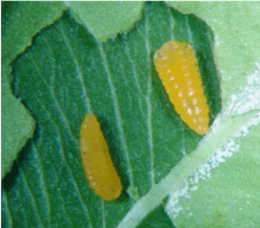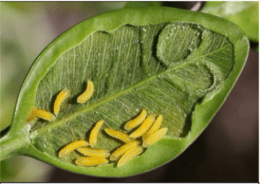From the KSU Entomology Newsletter

The boxwood leafminer, Monarthropalpus flavus, is a major insect pest of the common boxwood, Buxus sempervirens, which is a plant commonly used in landscapes throughout Kansas.
Boxwood leafminer adults emerge (eclose) from pupae when Weigela florida is flowering in the spring. Adults are 1/15 to 1/9 of an inch (2 to 3 millimeters) long, yellow-orange, and resemble mosquitoes or gnats (Figure 1).

Adults leave behind pupal cases attached to the leaf after emergence. After mating, females insert eggs inside the tissue of new leaves. A single female lays approximately 29 eggs and then dies afterward.
Larvae emerge (eclose) from the eggs in about three weeks. Larvae are legless maggots, yellow-white to green, and about 1/9 of an inch (3 millimeters) in length (Figure 2).

The larvae feed on the leaf tissue inside the leaf (Figure 3). Boxwood leafminer larvae tunnel between the upper and lower parts of leaf tissue creating blotched or irregular-shaped blisters on the lower leaf surface and raised areas on the upper leaf surface.
Learn more about boxwood leafminer and their control in an article by Dr. Raymond Cloyd by clicking HERE.
